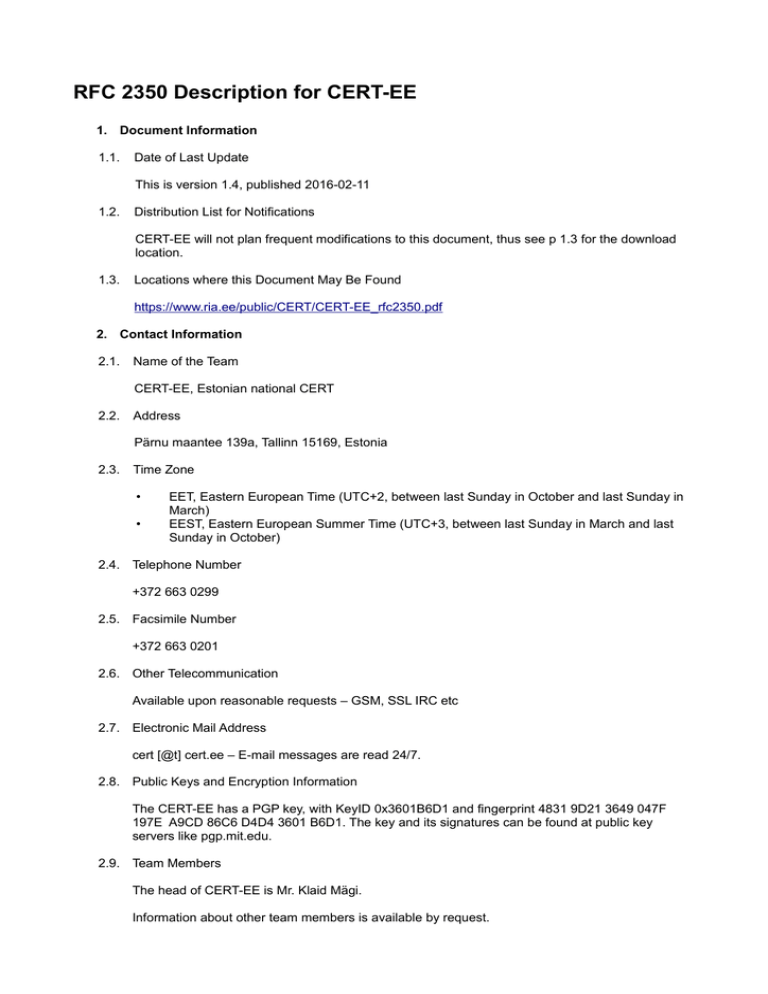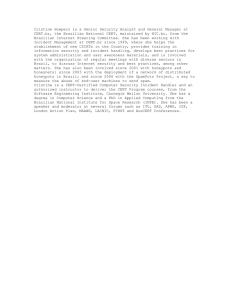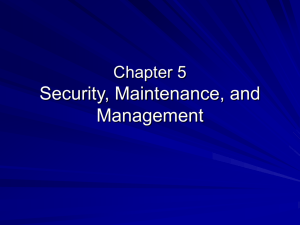RFC 2350 Description for CERT-EE
advertisement

RFC 2350 Description for CERT-EE 1. Document Information 1.1. Date of Last Update This is version 1.4, published 2016-02-11 1.2. Distribution List for Notifications CERT-EE will not plan frequent modifications to this document, thus see p 1.3 for the download location. 1.3. Locations where this Document May Be Found https://www.ria.ee/public/CERT/CERT-EE_rfc2350.pdf 2. Contact Information 2.1. Name of the Team CERT-EE, Estonian national CERT 2.2. Address Pärnu maantee 139a, Tallinn 15169, Estonia 2.3. Time Zone • • EET, Eastern European Time (UTC+2, between last Sunday in October and last Sunday in March) EEST, Eastern European Summer Time (UTC+3, between last Sunday in March and last Sunday in October) 2.4. Telephone Number +372 663 0299 2.5. Facsimile Number +372 663 0201 2.6. Other Telecommunication Available upon reasonable requests – GSM, SSL IRC etc 2.7. Electronic Mail Address cert [@t] cert.ee – E-mail messages are read 24/7. 2.8. Public Keys and Encryption Information The CERT-EE has a PGP key, with KeyID 0x3601B6D1 and fingerprint 4831 9D21 3649 047F 197E A9CD 86C6 D4D4 3601 B6D1. The key and its signatures can be found at public key servers like pgp.mit.edu. 2.9. Team Members The head of CERT-EE is Mr. Klaid Mägi. Information about other team members is available by request. 2.10. Other Information General information about CERT-EE is available at https://www.ria.ee/ee/cert.html (in Estonian) and https://www.ria.ee/en/cert-estonia.html (in English). CERT-EE Twitter profile (mostly in Estonian): https://twitter.com/CERT_EE CERT-EE blog (in Estonian): https://blog.ria.ee/ 2.11. Points of Customer Contact The preferred communication channel is the e-mail address cert [@t] cert . ee. If it's not possible to use e-mail, please call the official phone number indicated in p.2.4. Appropriate communication channels are advised according to the nature of the request. CERT-EE has one team member on duty 24/7. Facsimile machine is checked during normal office hours only. 3. Charter 3.1. Mission Statement The main goals for CERT-EE as the national CERT are: • promote secure networking; • deal with computer security incidents; • achieve fruitful cooperation among state players. 3.2. Constituency The main areas of responsibility of CERT-EE are: • dealing with information security incidents within AS8240 as well as with incidents in most of the state and municipal networks disregarding their exact affiliation or service provider. • serving as the single point of contact for foreign CERTs/CSIRTs, as the national CERT. Coordinating the activities in case of an elevated situation. • educating the nation and national IT sector on cyber threats, commenting the cyber security situation as necessary. 3.3. Sponsorship and/or Affiliation CERT-EE is a department of the Cyber Security Branch of the Information System Authority (https://www.ria.ee/en) and is funded on state budget. The other departments of the Cyber Security Branch are Risk Control and Advisory Department and Security Research and Development Department. CERT-EE is affiliated with FIRST, the global Forum of Incident Response and Security Team, as well as European regional forums TERENA (Trans-European Research and Education Networking Association) TF-CSIRT and TI (Trusted Introducer for European CERTs). CERT maintains affiliations with various CSIRTs around the world as needed. 3.4. Authority CERT-EE has no formal authority to advise particular actions (except actions related to AS8240). However, CERT-EE is a recognised participant of the tight information security community of Estonia. CERT-EE participates in security driven decisions for .ee TLD. 4. Policies 4.1. Types of Incidents and Level of Support Incident information obtained as a national CERT, is parsed, systematised and forwarded to ISP's and domain owners. The level of support depends on the type and severity of the incident or issue, and on the impact on Estonian critical infrastructure. Information System Authority coordinates wide level incidents on State level. Communication methods are in place to inform the owners of critical infrastructure, and for escalation up to the government level. As a general rule no end-user support is offered. 4.2. Co-operation, Interaction and Disclosure of Information CERT-EE works in tight cooperation with State Institutions, Law Enforcement Organisations (LEO) and professionals in the field. Standard privacy laws apply. In case of a potential criminal incident we recommend the proper LEO assessment. Rules and good practice are in place to avoid dissemination of private and company data. Cases and examples are disseminated in professional circles in an anonymised form. 4.3. Communication and Authentication For international communications ordinary precautions apply – like communicating to/via previously trusted and listed teams (TI) and using PGP. CERT-EE tries to adhere to LEO standards where key persons know each other personally before any significant cooperation. 5. Services 5.1. Incident Response CERT-EE will define, assess and prioritise all types of ICT incidents. In particular, it will provide assistance or advice with respect to the following aspects of incident management: 5.1.1. • • 5.1.2. • • • • 5.1.3. • • • Incident Triage Investigating whether indeed an incident occured. Determining the extent of the incident. Incident Coordination Determining and contacting the involved organisations. Facilitating contact with other parties including law enforcement, if needed. Asking for reports and/or composing reports, depending on the involved organisations, incident type and severity. Communicating with media, if necessary. Incident Resolution Advising the involved organisation(s) on appropriate measures. Following up the incident solution process. Collecting evidence and interpreting data, if applicable. 5.2. Proactive Activities • • • Providing relevant information on threats, trends and remedies to their constituency (and/or media, if necessary) to raise security awareness and competence. Collecting contact information of local security teams. Providing fora for community building and information exchange within the constituency. 6. Incident Reporting Forms https://www.ria.ee/ee/turvaintsidendist-teavitamine.html – CERT-EE expects the reporter to be able answer 3-5 standard questions (Where? When? What? How? Who?) and provide the assumptions according to the logs. 7. Disclaimers While every precaution will be taken in the preparation of information, notifications and alerts, CERTEE assumes no responsibility for errors or omissions, or for damages resulting from the use of the information contained within.



